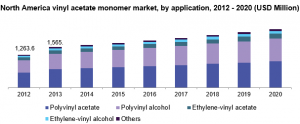Vinyl acetate monomer (VAM) is a significant intermediate used in the production of a wide range of resins and polymers for paints & coatings, adhesives, glues & sealants, elastomers, textile finishes, paper coatings, binders, films, and a myriad of other industrial and consumer applications. It efficiently homo-polymerizes to polyvinyl acetate (PVA), and VAM can be used in numerous random copolymers and terpolymers such as ethylene-vinyl acetate copolymers, vinyl-acrylic resins, vinyl acetate-acrylic acid copolymers, and vinyl acetate-vinyl chloride copolymers. With the wide diversity of the polymerization options, VAM has allowed the design of products with a wide spectrum of cost and performance profiles.
Related projects: - Chemicals (Organic, Inorganic, Industrial) Projects

Usage of Polyvinyl Acetate
The largest end-use for VAM is in the production of polyvinyl acetate resins as a base for adhesives and coatings, as well as a feedstock for derivative resins like polyvinyl alcohol (PVOH). Polyvinyl acetate emulsions and resins are low in cost and convenient to use, and they have a wide application range. PVA is likely best known as the base component of household white glues used for bonding paper, fabrics, wood, and plastic.
A fast-growing use of VAM is the manufacture of vinyl acetate-ethylene (VAE) and ethylene-vinyl acetate (EVA) copolymers. As the VAM content increases in an ethylene-vinyl acetate copolymer, crystallinity decreases and tensile properties decrease. However, flexibility, toughness and adhesive strength increase. At a level of 50 percent, EVAs are amorphous.
A wide variety of vinyl acrylic copolymer options are available. Vinyl acrylic emulsions are economical products that find extensive usage in interior architectural paints & caulks, adhesives & sealants, paper & textile binders, engineered fabrics, and pigment dispersions. Acrylic monomers like ethyl, butyl and 2-ethylhexyl acrylates enhance the performance of copolymers by improving flexibility, water resistance, adhesion, and scrub & stain resistance. Tre-monomers are also used like ethylene and acrylic acid in these systems.
Related Books: - Chemical Technology (Organic, Inorganic, Industrial), Fine Chemicals
Market Overview of Vinyl Acetate Monomer
The acrylic adhesives market is projected to grow from USD 8.84 Billion in 2017 to USD 11.72 Billion by 2022, at a CAGR of 5.81% between 2017 and 2022. Acrylic adhesives are versatile products that find application in varied industrial sectors. Growing usage of acrylic adhesives in end-use industries, improved quality of adhesives, and increased demand for durable adhesive products are the drivers for the market. The increasing demand in the developing Asia-Pacific region, high growth in end-use industries, and the shift in consumer preferences towards high-quality products are propelling the growth of the acrylic adhesives market. The demand for environmental benefits, such as reduced Volatile Organic Compound (VOC) emissions, and aesthetic bonding solutions for various substrates are expected to further fuel the growth of the acrylic adhesives market.

Medical is projected to be the fastest-growing application segment during the forecast period. Increasing aging population and advancements in medical devices such as lightweight and micro machineries will continue to fuel the use of UV curable and cyan acrylic adhesives in medical devices, including IV delivery systems, catheters, syringes, hearing aids, silicone rubber components, and others. Such developments and advancements are expected to propel the growth of the acrylic adhesives market, globally.
The acrylic polymer emulsion adhesives segment accounts for the largest share of the overall global acrylic adhesives market due to their easy availability and wide acceptability in applications such as paper & packaging and construction sectors. Water-based adhesives is the largest formulating technology segment, in terms of both value and volume. The increasing demand for VOC-free adhesives has given rise to the use of water-based acrylic adhesives in mature markets such as North America and Europe.
Related Videos: - Chemicals (Organic, Inorganic, Industrial)
Conclusion
Niir Project Consultancy Services (NPCS) makes detailed project reports on various topics. After doing the research it has made a project report on “Vinyl acetate monomer” NPCS has researched analyzing the market, confirming the availability of various necessities such as plant & machinery, raw materials to forecasting the financial requirements. The research at NPCS does the Market Surveys and Studies to get accurate data for the growth of the current market scenario and as well as future growth too.
Noo_Art21
Tags:-
#DetailedProjectReport #businessconsultant #BusinessPlan
#feasibilityReport #NPCS #industrialproject #entrepreneurindia #startupbusiness #BusinessIdeas #StartupBusinessIdeas #BusinessOpportunity #VinylAcetateMonomer #vinylacetatemonomermarket #ChemicalIndustry #ChemicalMarket #ChemicalManufacturing #ChemicalProduction